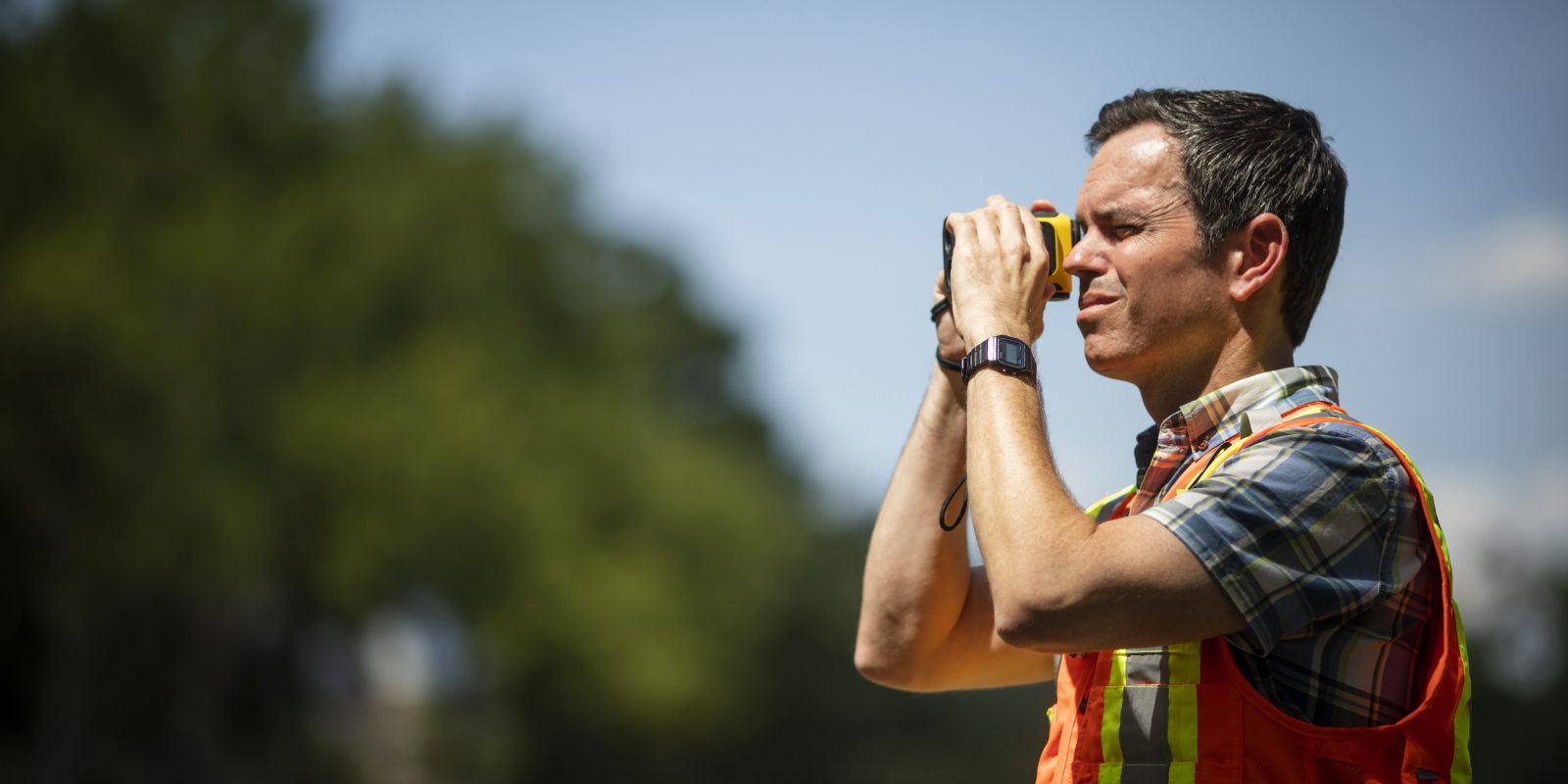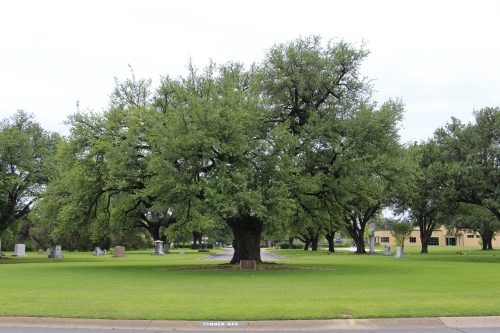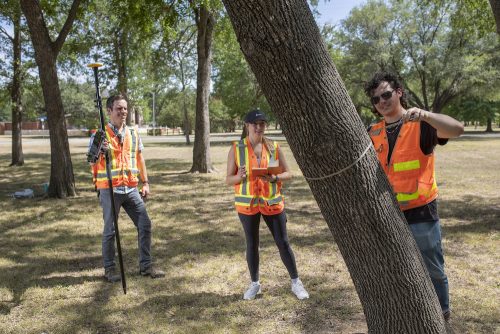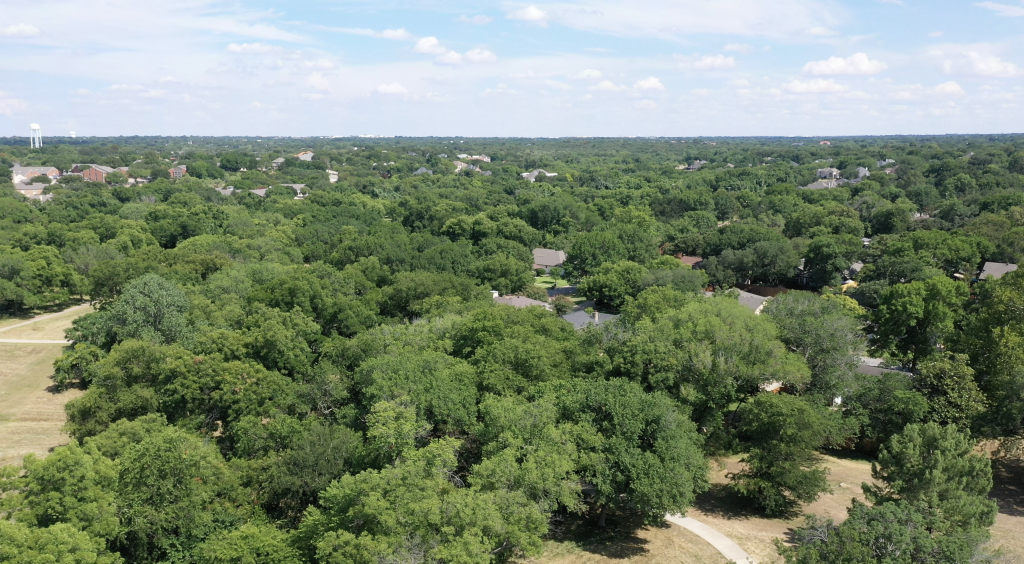
Brendan Lavy says sustainability is a new environmental ethic.
Saving The Urban Forest
Brendan Lavy is researching how tree preservation ordinances protect a valuable natural resource.
Standing at the entrance of Greenwood Memorial Park, the massive Turner Oak has been a part of Fort Worth since its founding more than 150 years ago. The tree, which tests show is more than 250 years old, has outlasted generations of residents as the city transformed into the 12th largest in the nation.

The Turner Oak, which stands at the entrance to Fort Worth’s Greenwood Memorial Park, is more than 250 years old, which means the oak rose from the ground more than a century before TCU’s founding. Courtesy of Fort Worth Park & Recreation Department
Southern live oaks reach their mature maximum trunk diameter within about 70 years, and some of the oldest in the country are several hundred to 1,000 years old, reports the National Wildlife Federation.
As cities across Texas continue to grow, “there’s concern for tree removal,” said Brendan Lavy, an assistant professor in the department of environmental and sustainability sciences at TCU. “It is much easier for developers to cut down trees rather than preserve them.”
People suffer along with the felled oaks and elms. Trees are “air conditioners for the local environment. Think of a parking lot in Texas summer: You’re looking for a spot that is shaded underneath a tree. Studies have also shown that trees also make us happier. People want to be around trees.”
City governments across the country have created preservation ordinances to protect the urban forest. Turner Oak is one of many stately trees specifically protected by Fort Worth’s regulations.
Since 2017, Lavy has been studying the scope of Texas tree preservation ordinances, which regulate what public and private landowners can and cannot do with trees on their properties.
Through a local lens, he is assessing what might be done about a global problem.
The planet’s tree population has declined by half since humans began to evolve, reports the World Wildlife Fund. The accelerating tree loss is speeding up the effects of climate change, destroying natural habitats and increasing soil erosion and subsequent destruction of crops.
As many as 15 billion trees are now being cut down every year across the globe. The rate of destruction is not sustainable.
UNDERSTANDING PRIORITIES
Tree protection ordinances are an important tool to ensure a livable planet for future generations.
Lavy and Ronald Hagelman, a professor in the department of geography at Texas State University, documented tree ordinances, which vary depending on each community’s goals and ideals, to understand Texas’ framework for protection.
They first obtained a list of Texas municipalities with ordinances from the International Society of Arboriculture. They verified, added to and updated that list, then extracted the purpose statements from each document to compare how each ordinance referenced the three dimensions of sustainability: environmental protection, economic stability and social equity.
“A sustainable ordinance,” Lavy said, “would address all three areas equally.”
These preservation documents are key to understanding the value humans put on protecting the Earth, Lavy said. “My view on sustainability is that it is a new environmental ethic. And as an ethic, sustainability emphasizes the inherent goodness of the Earth and its natural systems, the ecological limitations of unfettered economic growth and the advancement of intergenerational equity.”

Brendan Lavy works with his students Peter Fahey, right, and Kenna Mollendor in urban forests like this municipal park in Arlington, Texas.
Lavy and Hagelman found 63 Texas tree ordinances. Each document had a different agenda for protecting trees based on height, width and species. If a tree is protected, people must obtain a city permit to remove it. Some cities offer mitigation processes — a landowner can replace trees or fund tree replanting elsewhere. Cities can dole out penalties if trees are removed without a permit. Fines in Texas range from $500 to $2,000.
Most ordinances require permits for removing heritage trees — native species with aesthetic value and long lifespans. Fort Worth’s tree ordinance says trees of unusual size, age or species may be given heritage status. The term is also given to trees connected to a historical event and trees that serve as well-known landmarks or have significance to the community. Not all trees are sheltered by regulations, as almost half of Texas tree ordinances exempt single-family homes.
Research shows that private property contains 80 percent of trees within a city, Lavy said. “So, if you exempt single-family properties, then you’re leaving most of the urban forest unprotected.”
Gareth Harrier, a board-certified master arborist and Fort Worth resident, said many Texans live by the philosophy of “my house, my rules” and support limited government interference. “A lot of the ordinances will go after the big commercial developers and industrial sites.” Communities are more accepting of such ordinances, and they’re easier for small city staffs to enforce, he said.
But in most cases, efficiency-seeking developers have cut down trees and leveled the land rather than worked around the trees.
WORKING TOGETHER
In recent years, developers and environmentalists have found common incentives to protect the trees, Lavy said. “When it comes to sustainability, it can be developers versus the environmentalists, but that is not always the case. It’s really hard to point fingers at one entity, because there are good people doing good things on all points.”
In a field experience class, Lavy is teaching students how to quantify the benefits of trees to the urban environment. Measurements and calculations, Lavy said, include “carbon sequestration, energy saving and pollution removal.”
The more trees on the planet, the more carbon they can remove from the atmosphere. Trees shade houses in the hot Texas summers, which saves energy. They prevent heat from being reflected back into the atmosphere by shading parking lots and other concrete surfaces. Leaves remove air pollution through small holes on their undersides.
By putting a numerical value on the benefits that come through tree preservation, humans can better learn how — and why — to conserve the Earth’s ecosystem.
“Sustainability prioritizes intergenerational equity,” Lavy said. “Sustainability is not a trend. It has lasting power, and it is not going away.”

As many as 15 billion trees are now being cut down every year across the globe. The rate of destruction is not sustainable.

Your comments are welcome
1 Comment
Learning about Brendan Lavy’s work and the importance of urban forests encourages a fresh perspective on the role of nature in urban environments. It underscores the need for intentional planning and the integration of green spaces to create more sustainable and livable cities.
I’m grateful for the opportunity to explore this blog post and gain insights into Brendan Lavy’s dedication to urban forests. It serves as a reminder of the vital role that trees and natural elements play in our cities and the potential for creating healthier and more harmonious urban environments.
Related reading:
Latest News
To Save A Species
Woodrow Blagg’s detailed drawing captures TCU’s Rhino Initiative at work in Africa.
Campus News: Alma Matters
How can we conserve water for the future?
Three TCU water experts weigh in with practical advice.